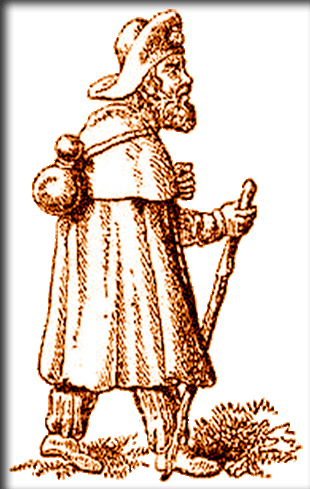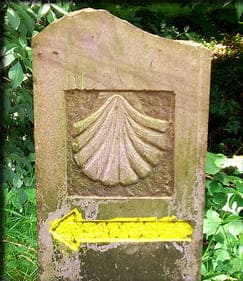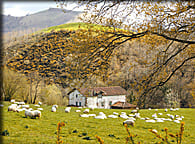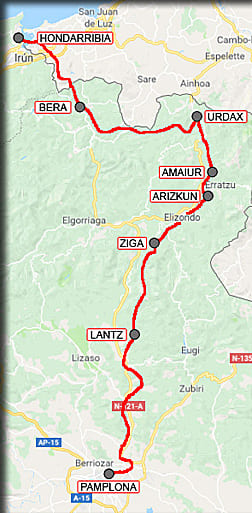


The route of this trip is designed to be enjoyed to the full. The first two stages of the Pilgrim's Way to Santiago Baztán route start in Bayonne and run through a somewhat monotonous French countryside. For this reason, we have replaced them for two much more attractive stages that cover the Franco-Spanish border, from Hondarribia to Urdax. In these first two stages you will go horseback riding through the rolling green mountains that constitute the border, enjoying fantastic views on both sides.
Once you arrive at Urdax, you will connect with the Pilgrim's Way to Santiago de Compostela through the Baztán and hike its last four stages, until you reach the city of Pamplona, where the famous San Fermín holiday take place in the first fortnight of July each year. This branch of the Camino de Santiago has been forgotten for many years and has recently been recovered for the enjoyment of those pilgrims who like to walk in solitude, avoiding the crowds of the saturated French Way, which it joins up with in Pamplona.

It is a very old route, used by many pilgrims since the Middle Ages, as witnessed by the many monuments that you will find along the route, including ancient roads, churches, hermitages, even a small hospital for pilgrims. As if this were not enough, this Pilgrim's Way to Santiago runs through an area which has almost unspoilt nature and idyllic villages where you will spend the night in cozy hotels and rural houses after having enjoyed each stage.


Walking North Spain is located in San Sebastian. The fact that we are a local travel agency has allowed us to select accommodation directly. We have been able to choose them in person. We visit them frequently and have direct contact with the owners.
For this trip we have selected the best establishments in the area. Some of them, especially at the beginning and end of the route, are 2 and 3 star hotels that offer all kinds of comfort in their spacious rooms. The other lodgings, which are found in the central stages, are small hotels and rural houses that offer all the charm of the authentic things. Its rooms are comfortable and clean, just as the hotels, they also have en-suite bathroom and, in general, have a rustic decoration typical of the mountainous area in which they are located.
Depending on when each trip is going to be made, we select the accommodation that are going to be used since some of them usually remain closed at different times of the year and, in addition, do not offer many rooms. Of course, we always choose the best accommodation options available and inform the client of the selection we have made for their trip.
In any case, all our accommodation offers high levels of comfort and quality. They are perfect places to rest after a beautiful day of walking and recharge batteries in order to enjoy the next stage, with a good dinner and breakfast
The Way of St. James through the valley of Baztán can be done at any time of the year, except from 16 December to the end of February. Between 15 September and 15 June, the best days to start the trip are Wednesdays and Thursdays, due to the opening dates of some of our preferred accommodation. However, you can arrive and start the route the day of the week that best suits your plans.
PRICES
Included:
(*) Possibility of organizing additional nights of accommodation along the route to have rest days and more time to visit interesting cities and places. Please check with us if you are interested.
Not included:
(**) Possibility to order private transfers from/to Biarritz, San Sebastián, Pamplona or Bilbao, at an additional charge.
How can I get to the area?
To start this trip, you must first arrive in San Sebastian or go directly to Hondarribia, where you will stay the first night. You can get there by plane, either to the San Sebastian airport (which is just at Hondarribia), or to the nearby airports of Biarritz or Bilbao, from where there are bus lines that connect quickly with San Sebastian. From these airports you can also come by taxi or request a private transfer (with additional charge). Of course, you can also come in your own vehicle or use the existing train and bus lines from Madrid or Barcelona. For more information, see the "How to get here" section of the "Information" tab.
What currency and language is used in the area?
The first stage of this route runs almost entirely through France, while the rest of the stages run through Spain. In both countries, the currency used is the euro. With regard to languages, of course, French is spoken in France and Spanish in Spain, but throughout this area, Euskera, the language of the Basque people is also spoken, one of the oldest and most mysterious languages in the world. While you are here, you will often hear and read it many times and we will tell you some curious facts about this ancient language on your arrival. English is spoken in practically all accommodations and towns, although in some cases the level may be basic.
Is it a very saturated route?
Not at all, this is probably the least saturated Way of Saint James of all those that cross the Iberian Peninsula. It is a very old route that has been reopened a few years ago, so few pilgrims know and travel it today. Therefore, it is very attractive and appreciated by those pilgrims who like to walk in solitude. If this is your case... walk this route as soon as possible!
Is it easy to find your way around or follow the route?
Yes, the first two stages (which are not part of the Pilgrim's Way to Santiago de Compostela) run along paths that are well signposted. In addition, the stages of the Camino de Santiago have their usual yellow arrows and wooden posts, so they are very easy to follow. Also, remember that we will provide you with detailed information in our route cards.
Is it a safe route?
Yes, fortunately, this area is very safe and pilgrims do not usually have any problems on their way, even if they are walking alone. In addition, the routes all pass through inhabited villages and hamlets and always begin and end in important centres of population. Also, remember that our agency is located in San Sebastian and that you can contact us at any time, either through the accommodation where you are staying, or directly to the contact telephone number that we will give you on your arrival.
Can I book a one-person trip?
Although it is ideal to be able to share the experiences of the Pilgrim's Way to Santiago with other people, it is possible to book this trip for individuals, with an additional supplement (please consult prices in the Dates/Prices tab).
What is the best time of year to make this trip?
Probably the best times to travel this Camino de Santiago are spring (April, May and June) and autumn (September, October and November). Summer (July and August) can also be a good time, but some days the temperature can be a little high.
Is it possible to shorten some stages?
Yes, if you don't want to walk all or part of any of the stages, you can shorten them by hiring a private taxi service, which you should pay directly to the driver. This taxi can be hired the day before, either directly in the accommodation where you are or by contacting us.
I have some kind of dietary restriction, is it possible to take this into account?
Of course, in that case we will notify this circumstance to all the accommodations and restaurants we work with. However, it should be borne in mind that the route crosses rural areas and, in some cases, there may be some limitation on the choice of menus of restaurants because, as they are in small villages, they may not have as wide an offer as restaurants in larger towns usually have.
If you have any other questions, please click here and send us an e-mail. Thank you very much.
We use cookies to ensure that we give the user the best experience on our website. If you continue to use this site we assume that you agree with our cookie policy. Privacy and Cookie policy Ok.